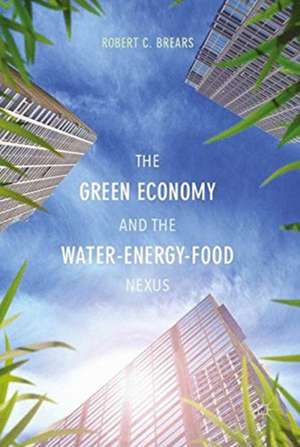The Green Economy and the Water-Energy-Food Nexus
Autor Robert C. Brearsen Limba Engleză Paperback – 4 noi 2020
This book argues that a variety of policies will be required to create synergies between the water-energy-food nexus sectors while reducing trade-offs in the development of a green economy. Despite rising demand for water, energy and food globally, the governance of water-energy-food sectors has generally remained separate with limited attention placed on the interactions that exist between them.
Brears provides readers with a series of in-depth case studies of leading cities, states, nations and regions of differing climates, lifestyles and income-levels from around the world that have implemented a variety of policy innovations to reduce water-energy-food nexus pressures and achieve green growth.
The Green Economy and the Water-Energy-Food Nexus will be of interest to town and regional planners, resource conservation managers, policymakers, international companies and organisations interested in reducing water-energy-food nexus pressures, environmental NGOs, researchers, graduate and undergraduate students.
| Toate formatele și edițiile | Preț | Express |
|---|---|---|
| Paperback (1) | 644.18 lei 6-8 săpt. | |
| Palgrave Macmillan UK – 4 noi 2020 | 644.18 lei 6-8 săpt. | |
| Hardback (1) | 1007.03 lei 6-8 săpt. | |
| Springer International Publishing – 20 sep 2023 | 1007.03 lei 6-8 săpt. |
Preț: 644.18 lei
Preț vechi: 757.85 lei
-15% Nou
Puncte Express: 966
Preț estimativ în valută:
123.28€ • 127.97$ • 102.79£
123.28€ • 127.97$ • 102.79£
Carte tipărită la comandă
Livrare economică 22 martie-05 aprilie
Preluare comenzi: 021 569.72.76
Specificații
ISBN-13: 9781349844609
ISBN-10: 1349844608
Pagini: 423
Ilustrații: XIV, 423 p.
Dimensiuni: 148 x 210 mm
Greutate: 0.52 kg
Ediția:1st ed. 2018
Editura: Palgrave Macmillan UK
Colecția Palgrave Macmillan
Locul publicării:London, United Kingdom
ISBN-10: 1349844608
Pagini: 423
Ilustrații: XIV, 423 p.
Dimensiuni: 148 x 210 mm
Greutate: 0.52 kg
Ediția:1st ed. 2018
Editura: Palgrave Macmillan UK
Colecția Palgrave Macmillan
Locul publicării:London, United Kingdom
Cuprins
1. introduction.- 2. The Green Economy.- 3. The Green Economy and Sustainable Development.- 4. Policy Tools to Reduce Water-Energy-Food Nexus Pressure.- 5. The Green Economy and the Water-Energy-Food Nexus in New York City.- 6. The Green Economy and the Water-Energy-Food Nexus in Singapore.- 7. The Green Economy and the Water-Energy-Food Nexus in Massachusetts.- 8. The Green Economy and the Water-Energy-Food Nexus in Ontario.- 9. The Green Economy and the Water-Energy-Food Nexus in Denmark.- 10. The Green Economy and the Water-Energy-Food Nexus in Korea.- 11. The Green Economy and the Water-Energy-Food Nexus in the Colorado River Basin.- 12. The Green Economy and the Water-Energy-Food Nexus in the Murray-Darling River.- 13. The Green Economy and the Water-Energy-Food Nexus in the Rhine River Basin.- 14. Best Practices.- 15. Conclusions.
Notă biografică
Robert C. Brears is the founder of Mitidaption, Mark and Focus, and is Director on the International Board of the Indo Global Chamber of Commerce, Industries and Agriculture.
Textul de pe ultima copertă
This book argues that a variety of policies will be required to create synergies between the water-energy-food nexus sectors while reducing trade-offs in the development of a green economy. Despite rising demand for water, energy and food globally, the governance of water-energy-food sectors has generally remained separate with limited attention placed on the interactions that exist between them.
Brears provides readers with a series of in-depth case studies of leading cities, states, nations and regions of differing climates, lifestyles and income-levels from around the world that have implemented a variety of policy innovations to reduce water-energy-food nexus pressures and achieve green growth.
The Green Economy and the Water-Energy-Food Nexus will be of interest to town and regional planners, resource conservation managers, policymakers, international companies and organisations interested in reducing water-energy-food nexus pressures, environmental NGOs, researchers, graduate and undergraduate students.
Caracteristici
Presents a series of case studies that illustrate how cities, states, nations and regions of differing climates, lifestyles and income-levels have implemented policies to reduce water-energy-food nexus pressures Discusses the components of the food-water-energy nexus and the pressures it faces from rapid economic growth and climate change Provides a review of the various fiscal and non-fiscal tools available for reducing the global demand on the water, energy and food sectors
